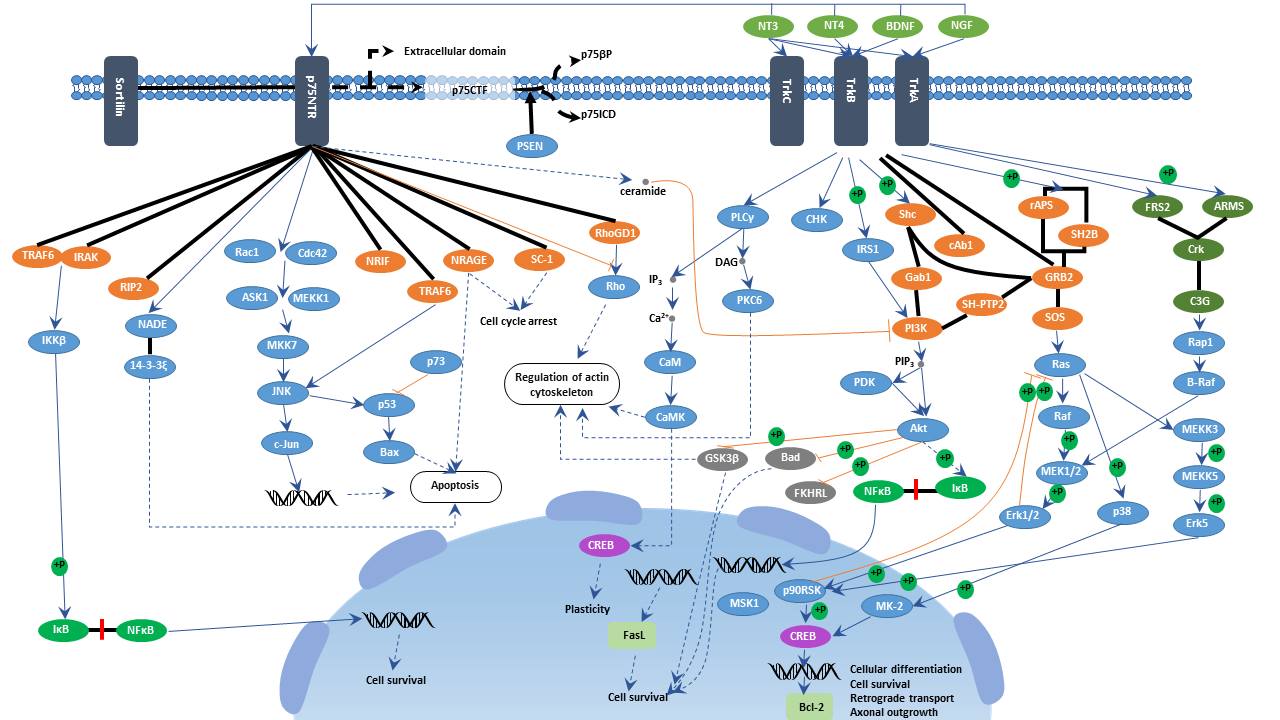
What Are Neurotrophins?
Neurotrophins are a group of proteins that induce the survival, development, and function of neurons. There are four structurally related neurotrophins: nerve growth factor (NGF), brain-derived neurotrophic factor (BDNF), neurotrophin-3 (NT-3), and neurotrophin-4 (NT-4).
The nerve growth factor is the first found neurotrophin. It is a typical target-derived neurotrophic factor and is produced by the target neuron tissue, taken up by the axon tip, and retrogradely transported to the cell body. Studies have confirmed that nerve growth factor only participates in the survival and apoptosis of a limited number of neurons. For example, the nerve growth factor is necessary for the survival and maintenance of the sympathetic neurons and some sensory neurons, but the neurons of the central nervous system do not require NGF for survival.
In 1982, German neurobiologist Barde YA et al. isolated a small protein molecule from pig brain. Because this protein molecule has high similarity with NGF and pigs, rats, mice & humans have exactly the same amino acid sequence of the protein, it is classified as a member of the neurotrophin family and named brain-derived neurotrophic factor. BDNF is widely distributed in the central nervous system and plays an important role in learning, memory, and mediating synaptic transmission.
NT-3 is a secretory basic neurotrophic factor expressed throughout the development of the nervous system and into adulthood. It is involved in many events that regulate nerve development, including the development & survival of neurons, the proliferation, differentiation & survival of oligodendrocyte precursors (OLPs), and the correct formation and signal transmission of synapses.
NT-4 controls the survival and differentiation of vertebrate neurons. The expression of NT-4 is ubiquitous and less influenced by the environmental signals. All other neurotrophin knock-outs have proven lethal during early postnatal development, mice deficient in NT-4 have so far only shown tiny cellular deficits and develop normally to adulthood.
What Is Neurotrophin Signaling Pathway?
In the neurotrophin signaling pathway, neurotrophins bind to their respective receptors on the target cell, inducing the occurrence of multiple intracellular signaling pathways and thus mediating many important downstream cellular processes.
The Function of Neurotrophin Signaling Pathway
The neurotrophin signaling pathway is regulated by connecting various intracellular signaling cascades including the MAPK pathway, PI3K pathway, and PLC pathway, all of which crosslink and trigger some important effects such as differentiation, survival, and axonal outgrowth of neurons.
The Process of Neurotrophin Signaling Pathway
Neurotrophins exert their biological effects through engagement of Trk (tyrosine kinase) receptors or p75 neurotrophin receptor (p75NTR). The Trk receptor contains three subtypes: Trk A, Trk B, and Trk C, and they are all specific for different neurotrophins. p75NTR can bind to all neurotrophins.
Neurotrophins bind to Trk receptors, stimulating receptor transphosphorylation, which results in the recruitment of a series of signaling proteins to the docking sites on the receptor. These proteins include Shc, which activates Ras through Grb-2 and SOS, FRS-2, rAPS, SH2-B, and CHK. All these signaling molecules participate in activating MAPK, and PLC-γ1. Shc and FRS-2 bind to phosphorylated Tyr490 of TrkA, while PLC-γ1 and CHK bind to phosphorylated Tyr785. MAPK activity is also regulated through Raf, Rap1, SHP-2, and PKCδ. Trk activates PI-3K through the Ras and the Gab-1/IRS-1/IRS-2 family of adapter proteins. Active PI-3K activates PDK1 and PDK2, which in turn activate Akt. The targets of Pl-3K/Akt anti-apoptotic activity include BAD, Forkhead, GSK-3, Bcl-2, IAP, and the p53 cell death pathway.
BDNF and its high-affinity receptor TrkB are widely distributed in the central nervous system such as pain transmission pathways. BDNF binds to the TrkB receptor with high affinity, inducing the dimerization of the molecular receptor. The TrkB receptor dimerization leads to phosphorylation and activation of intracellular signal cascades such as PI3K, PLC-γand extracellular signal-regulated kinase, which are involved in promoting neuron development, differentiation, and regeneration, ultimately leading to a series of biological effects such as synaptic transmission, enhanced synaptic plasticity, and long-term potentiation of neurons.
NT-3 binds to the TrkC receptor on the cell membrane, inducing the phosphorylation of TrkC, which activates downstream intracellular signaling pathways, including the ERK1/2 pathway that promotes neuronal differentiation and the PI3K/Akt pathway that supports the survival of new neurons. NT-4 seems to have the unique requirement of binding to the low-affinity neurotrophin receptor (p75LNGFR) for efficient signaling and retrograde transport in neurons.
p75NTR transmits both positive and negative signals. These signals play an important role in neural development and additional higher-order activities such as learning and memory. Different from Trk receptors, the p75NTR has the opposite effect. When it binds to the neurotrophin, it causes nerve cell death.
Diseases Associated with Neurotrophins
As an important member of the neurotrophic factor family, BDNF is very important for nerve development and growth. Abnormal expression of BDNF / TrkB often leads to the occurrence of neurological diseases such as depression, Huntington's disease, Parkinson's disease, and Alzheimer's disease. Studies have found that BDNF concentrations in serum and plasma of patients with depression are reduced, whereas the expression levels of BDNF and TrkB tend to increase in cancer tissues of tumor patients and the BDNF levels in serum of cancer patients are lower than normal people. This may explain why tumor patients often feel depressed even tend to suicide.
To counteract the negative effects of neurotrophins, a popular treatment nowadays is to control the loss of nervous system function by increasing the neurotrophin levels. Unfortunately, when neurotrophins are used as medicines, they do not last long in the body and they also bring significant adverse effects. So far, researchers are looking for other drugs that can trick cells into working states that receive signals from neurotrophins.





